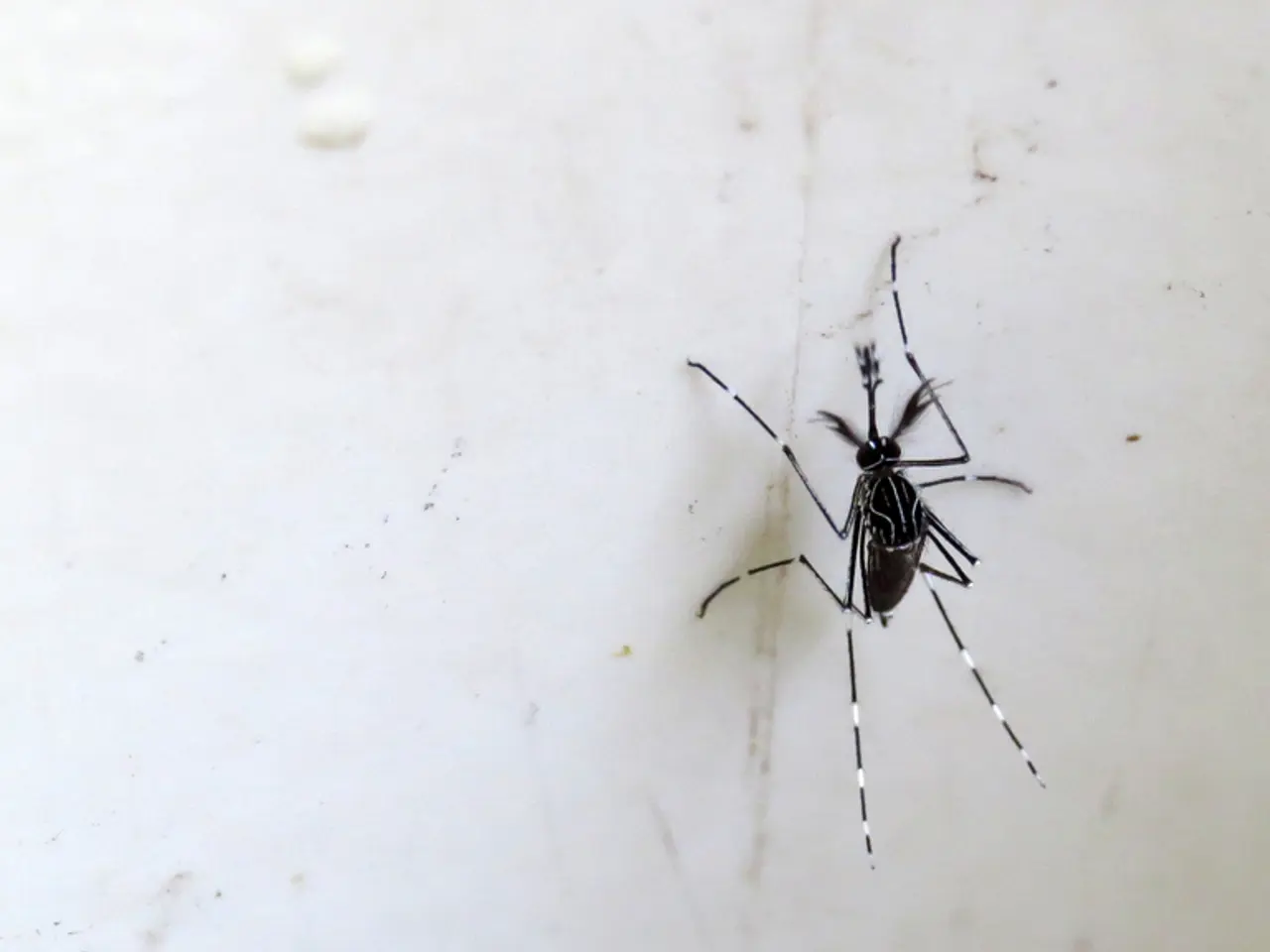Unprecedented Virus Threat: Assessing the Severity of Chikungunya - Unspeakable Virus: Exploring the Potential Threat of Chikungunya
In recent news, the first case of the Chikungunya virus in Alsace, France, has raised concerns about potential outbreaks in the southwest region of Germany, particularly in Baden-Württemberg. This mosquito-borne virus, prevalent mainly in Asia, Africa, and America, can cause fever, headache, and joint pain, and there are currently no specific medications for its treatment.
The Asian tiger mosquito, one of the primary carriers of the Chikungunya virus, was first detected in Freiburg im Breisgau and Heidelberg in 2015. Since then, the species has spread further in warmer regions of Germany, including the Upper Rhine, the Rhine-Neckar region, and the middle Neckar, as well as Lake Constance. Tiger mosquitoes are found in various regions, but specific information about the regions where they are present was not provided.
To protect against tiger mosquitoes in gardens or on balconies, it's important to eliminate potential breeding sites by regularly checking for standing water in various items and sealing rain barrels with a tight-fitting lid. For those traveling to affected regions, protection against mosquitoes is crucial. This includes using DEET or Icaridin-based sprays, mosquito nets, window screens, wearing long, wide, and light clothing at night, as well as using fans.
In response to the growing threat, Baden-Württemberg's approach integrates surveillance, vector control, vaccination, and symptomatic treatment. Public health authorities follow guidance on assessing and mitigating the risk of Aedes mosquito-borne viruses, including chikungunya. This involves continuous epidemiological and entomological surveillance to detect any locally acquired cases and monitor vector presence. Risk levels guide the intensity of public health responses, from enhanced surveillance and prevention at low risk levels to active response and vector control at higher risk levels.
Prevention relies heavily on controlling Aedes mosquitoes, the primary vectors of chikungunya. Measures include public awareness campaigns about mosquito bite prevention, elimination of breeding sites (stagnant water), and targeted vector management activities coordinated across sectors to reduce mosquito populations and interrupt transmission.
As of April 2025, the European Commission authorized the IXCHIQ vaccine to prevent chikungunya virus disease in individuals aged 12 to 64 years in the EU, including Germany. This vaccine is recommended especially for people at higher risk or traveling to outbreak areas. There have been vaccination campaigns targeting prioritized groups to prevent severe disease and control outbreaks. Ongoing monitoring of vaccine safety is part of the strategy.
In addition, another Chikungunya vaccine, Vimkunya, was approved in February 2025. However, Ixchiq is currently under review by the European Medicines Agency (EMA) due to reports of severe side effects in older people.
In Baden-Württemberg, health departments and tropical medicine institutes, such as the one in Heidelberg, are the first points of contact for those feeling ill, having fever or joint pain after returning from risk areas like Mauritius or La Réunion, or after a mosquito bite near the border. Treatment is primarily supportive, focusing on relieving symptoms such as fever and joint pain with analgesics and anti-inflammatory drugs. Hydration and rest are also advised. Severe cases may require specialized care, but no curative treatment currently exists.
It's important to note that once Chikungunya is cured, there is lifelong immunity to the disease. At present, the risk of Chikungunya virus spread remains low, but after the first local infection in Alsace, similar cases in the southwest cannot be ruled out.
In conclusion, Baden-Württemberg's approach integrates surveillance, vector control, vaccination with IXCHIQ, and symptomatic treatment to prevent and manage Chikungunya virus infections within the region. As the situation evolves, it is crucial for the public to stay informed and take necessary precautions to protect themselves from this mosquito-borne virus.
[1] Baden-Württemberg Ministry of Health and Social Affairs. (2025). Chikungunya Response Plan. Retrieved from [www.mgsa.ba-bw.de/chikungunya](http://www.mgsa.ba-bw.de/chikungunya) [2] Robert Koch Institute. (2025). Chikungunya Virus - Frequently Asked Questions. Retrieved from [www.rki.de/chikungunya](http://www.rki.de/chikungunya) [3] European Medicines Agency. (2025). CHIKVIX (ixefixirine) - Product Information. Retrieved from [www.ema.europa.eu/en/medicines/human/EPAR/chivix](http://www.ema.europa.eu/en/medicines/human/EPAR/chivix) [4] European Medicines Agency. (2025). Vimkunya (rCHIKV) - Product Information. Retrieved from [www.ema.europa.eu/en/medicines/human/EPAR/vimkunya](http://www.ema.europa.eu/en/medicines/human/EPAR/vimkunya) [5] World Health Organization. (2025). Chikungunya. Retrieved from [www.who.int/health-topics/chikungunya#tab=tab_1](http://www.who.int/health-topics/chikungunya#tab=tab_1)
- The Commission's proposal for a directive on the protection of workers from the risks related to exposure to ionizing radiation, rooted in scientific advancements and environmental science, highlights the importance of promoting health and wellness, fitness and exercise, and lifestyle modifications to minimize risks in various industries, including space and astronomy.
- Amid concerns about climate change and its impact on global health and nutrition, it is crucial for individuals to seek accurate, reliable information about the potential effects of changing environmental conditions on their medical-conditions and general well-being.
- As electric vehicles gain popularity for their contribution to reducing carbon emissions and promoting sustainable transportation, car-maintenance practices also need to prioritize energy efficiency and eco-friendly practices to minimize their environmental Impact.
- In a world where travel is increasingly accessible, it is essential to be aware of the potential health risks and necessary precautions when visiting affected regions to contract mosquito-borne diseases such as Chikungunya virus.
- Preventative measures in lifestyle choices, such as proper nutrition and regular fitness and exercise, contribute to overall immunity against various illnesses, including the Chikungunya virus, as well as facilitating recovery from medical-conditions.
- The European Medicines Agency (EMA) regulates various pharmaceutical products, including vaccines, to ensure their safety and efficacy, such as for the IXCHIQ vaccine, which target-fights against the Chikungunya virus.
- The integration of surveillance, vector control, vaccination, and symptomatic treatment serves as an effective approach to managing the Chikungunya virus outbreak in regions such as Baden-Württemberg, while ongoing public education and awareness efforts remain key components in mitigating the impact of such infectious diseases on the region's population.




